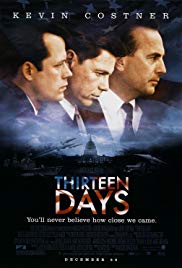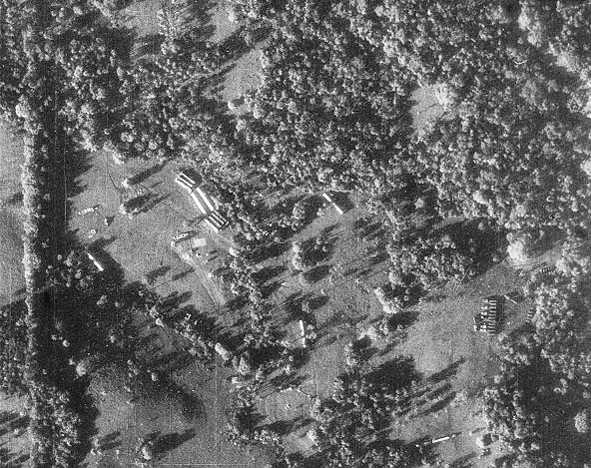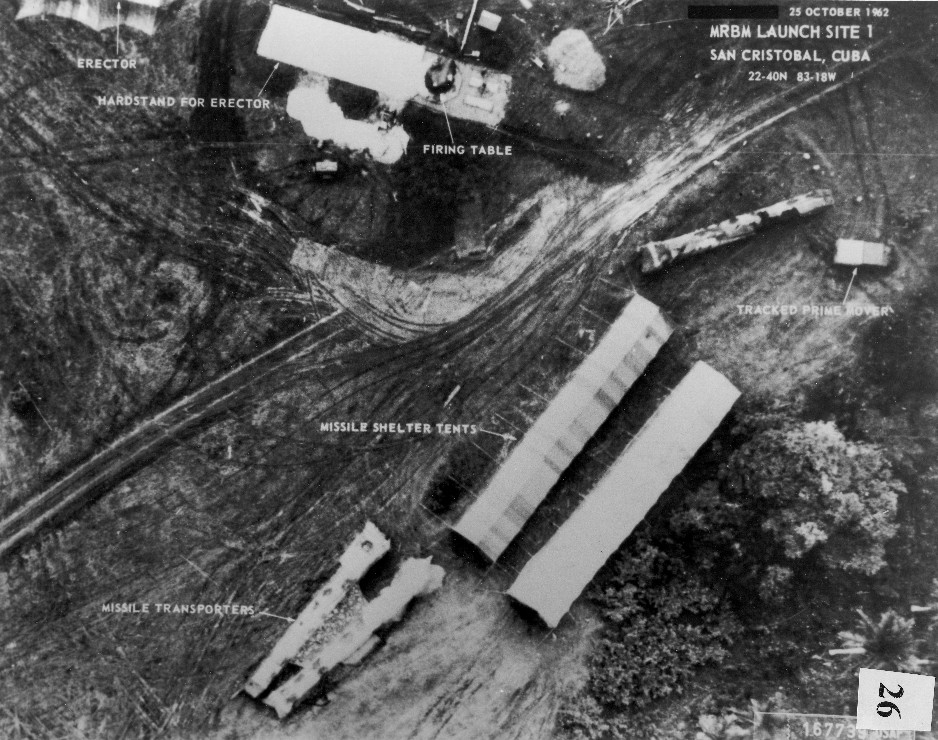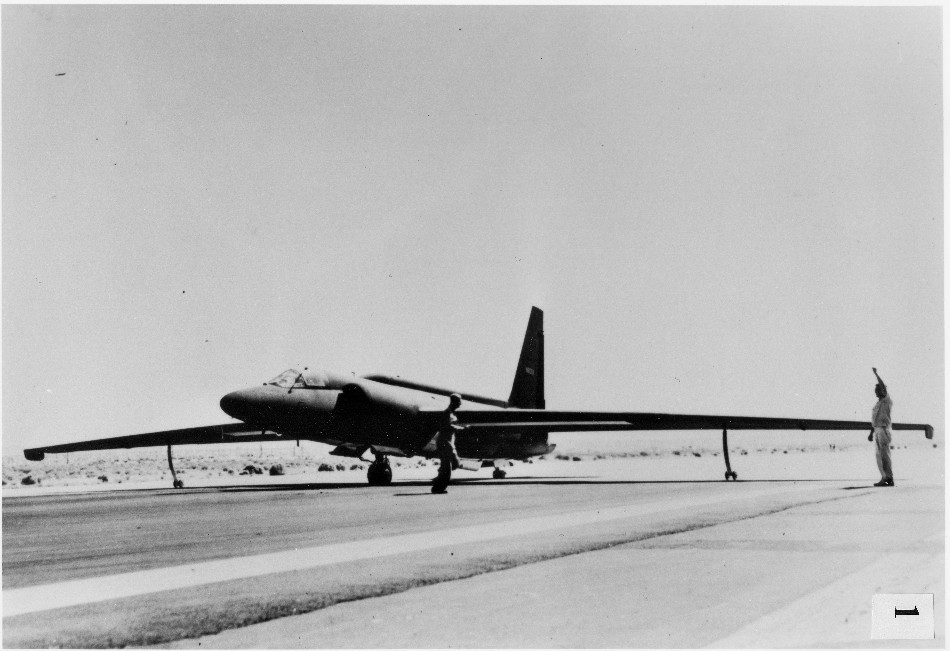1. See Standard Questions Suitable for Any Film.
No suggested Answers.
2. How close were we to nuclear war in the Cuban Missile Crisis? State the facts which support your answer.
Suggested Response:
We were very, very close. See the section entitled “WERE WE REALLY THAT CLOSE TO NUCLEAR WAR?”
3. Who bears responsibility for the Cuban Missile Crisis? Give the reasons for your opinion.
Suggested Response:
See the section entitled “WHO BEARS RESPONSIBILITY FOR THIS CLOSE BRUSH WITH NUCLEAR WAR?”
4. Why did the Soviets want to put nuclear missiles in Cuba? Justify your response.
Suggested Response:
See the section entitled, “WHY DID KHRUSHCHEV BACK DOWN?”
5. Why was the resolution of the Cuban Missile Crisis considered a personal triumph for President Kennedy? Describe your reasons for this opinion.
Suggested Response:
See the section entitled “WHY WAS THE CUBAN MISSILE CRISIS CONSIDERED SUCH A SUCCESS FOR PRESIDENT KENNEDY?”
6. What was Khrushchev’s key miscalculation when he was planning to place missiles in Cuba and why did he make that mistake?
Suggested Response:
See the section entitled “WHY DID KHRUSHCHEV BACK DOWN?”, second paragraph.
7. Why did Khrushchev back down? Describe the facts and reasons that support your response.
Suggested Response:
See the section entitled “WHY DID KHRUSHCHEV BACK DOWN?”
8. Describe three major misimpressions left by the movie.
Suggested Response:
See the section entitled “HOW ACCURATE IS THE MOVIE?”
9. Who in the Russian government had the “bright idea” to put nuclear missiles in Cuba and who made the final decision on that policy?
Suggested Response:
Nikita Khrushchev.
10. In the movie, the O’Donnell character asks Bobby Kennedy to consider whether the hostile second letter was the result of the feelers that he and his brother (the President) had sent to Khrushchev which offered to trade the obsolete NATO missiles in Turkey for the Russian missiles in Cuba. What do you think of that theory?
Suggested Response:
The second letter from Khrushchev was the direct result of the suggestions by President Kennedy that he might be willing to add the missiles in Turkey to the deal. Khrushchev was trying to take advantage of the situation and change his first offer. Click here for more on this subject.
11. In the movie at the end, the McNamara character (Secretary of Defense) and the McCone character (Director of the CIA) have a conversation in which they mention “running the table” on the Russians in several locations, including Asia. What happened to the U.S. in Vietnam and what principle in history does this scene illustrate?
Suggested Response:
The U.S. lost the Vietnam War after many casualties and great expense. This scene demonstrates the dialectic nature of historical struggles. Success in one area can lead to overconfidence in another that results in a later defeat.
12. Given the fact that both the U.S. and the U.S.S.R. already had enough nuclear weapons to obliterate each other’s major cities within a few minutes, why was the U.S. so alarmed that the Russians put missiles in Cuba? (Another way to ask the same question is: “Given the fact that the introduction of medium-range ballistic missiles in Cuba did not really change the nuclear balance of power, was it irresponsible for President Kennedy to risk a nuclear war to remove the missiles?”)
Suggested Response:
The question states one argument, why go to nuclear war over something unimportant? The other reasons are summarized in the first bullet of the section entitled “HOW ACCURATE IS THE MOVIE?” Click here to jump to that section.
13. If the U.S. had publicly agreed to trade the missiles in Turkey for the Russian missiles in Cuba, would the U.S. have been making a concession similar to those made by France and Britain at the Munich conference before the Second World War?
Suggested Response:
Taking the missiles out of Turkey was not like Munich in that President Kennedy knew the missiles in Turkey were obsolete and scheduled to be replaced by submarine-based missiles. (In fact, President Kennedy had ordered the Turkish missiles removed before the Cuban missile crisis but those orders had not been carried out.) At the Munich conference, the Germans obtained a great benefit, i.e., Germany was given large amounts of territory, and it obtained possession of the Czech fortifications in the only natural barrier between Germany and the rest of Czechoslovakia. The situation in 1962 was like Munich in that the Soviets wanted the missiles out of Turkey, and if they obtained their goal through intimidation and aggressive actions, the political victory might have encouraged them to make more demands. Overall, it appears that taking the missiles out of Turkey would not have been appeasement because the missiles were already obsolete and scheduled to be replaced with a more formidable threat to the Soviets, submarines carrying nuclear missiles.
14. President Kennedy worried that a surprise pre-emptive attack on Cuba would be the moral equivalent of Japan’s attack upon the United States at Pearl Harbor. Was this fear justified?
Suggested Response:
In 1941 Japan made an unprovoked sneak attack on the U.S. naval base at Pearl Harbor. Japan felt that U.S. economic sanctions were hampering its war of expansion in Asia. In the case of the Cuban Missile Crisis, the Castro government was secretly permitting a hostile foreign power to install nuclear weapons aimed at the U.S. This was clearly a direct hostile act in itself and therefore, would have been much different than U.S. actions toward Japan in the South Pacific before WWII. President Kennedy was engaging in historical hyperbole. However, there were other reasons to avoid a pre-emptive strike on Cuba, specifically, (1) it had not been proven that it was impossible to force the Russians to remove their nuclear missiles using less force than a pre-emptive strike or an invasion; (2) an invasion with a pre-emptive strike was extremely risky because the U.S. could not be sure to have destroyed all the nuclear weapons, and it would take only one nuclear strike on the U.S. to start a nuclear war with the Soviet Union; and (3) it was possible that the invasion would not be successful or that it would be much more difficult that we had expected. This is always the case in war. In fact, unknown to President Kennedy or the U.S. government, there were 40,000 Red Army troops in Cuba equipped with battlefield nuclear weapons. Their mission was to defend the island and the local Soviet commanders had authority to use nuclear weapons if they were attacked.
15. President Kennedy convened a large group of military leaders and foreign affairs experts in a team known as Excomm. Was the large body of advisors counterproductive (i.e. “too many cooks spoil the broth”)? What are the pros and cons of large advisory groups? What are the pros and cons of President Kennedy alone making the choices, without the input of a large advisory body?
Suggested Response:
There is no one right answer to this question. Good answers should include some of the following concepts: The advantages of involving a large group include: (1) the President is exposed to a wide range of opinions and ideas; (2) a group of people working on a problem can often come up with alternatives and ideas that a single person, no matter how intelligent, would not have considered; (3) a large group, if properly managed, would aid in establishing a political consensus and a unified front against the Russians. The disadvantages of involving a large group are: (1) it is difficult to keep deliberations secret; (2) bureaucratic and political forces might be unleashed which affect one’s course of conduct (e.g., the movie attempts to show that some members of the military tried to box the President into starting an invasion or conducting a pre-emptive strike; note that the treatment of the military is one area in which the historical accuracy of the movie has been questioned); (3) large groups try to make decisions by compromise which is very risky; ultimately there should be one decision-maker who weighs all of the arguments and makes a decision; and (4) if not properly managed a large group could result in division and weaken the ability to carry out policy.
16. Ambassador to the United Nations Adlai Stevenson recommended the option of making substantial concessions to the Russians in addition to agreeing not to invade Cuba. Does the high cost of nuclear war justify the price of peace in the midst of a Cold War between the U.S. and the Soviets?
Suggested Response:
If it was simply a choice between peace with some concessions and war, the answer is easy. But that is almost never the choice. Munich taught us that one concession is usually followed by a demand for another, and on and on until war results from miscalculation or when the aggressor simply goes too far. Wisdom is knowing the difference between a concession and a legitimate compromise. History has judged the pledge not to invade Cuba to have been a legitimate compromise while additional concessions might have been appeasement. There was no U.S. policy to invade Cuba and while Kennedy wanted to depose or assassinate Castro, he could and did say that the U.S. was giving up nothing by agreeing not to invade Cuba. (We don’t believe removing the missiles from Turkey would have been appeasement because they were obsolete.) Paradoxically, the threat of nuclear war by both countries preserved the peace during the Cold War. MAD (Mutual Assured Destruction) actually worked to prevent nuclear war. See Learning Guide to “Dr. Strangelove“.
17. Bobby Kennedy disparages the sneak attack option. “It sounds so easy . . . like the Bay of Pigs Operation did at first.” What was the Bay of Pigs Operation? Why did it fail? Would a full-scale American invasion have been different than an attack by Cuban exiles?
Suggested Response:
Bobby Kennedy was referring to the situation in which all of the President’s major advisors told him that the Bay of Pigs invasion would be successful. During the Cuban Missile Crisis, the military predicted success in Cuba, unaware that the U.S. armed forces would come up against 40,000 Red Army troops equipped with tactical nuclear weapons. A full scale U.S. invasion would have been much different than the puny Bay of Pigs effort. However, like the Bay of Pigs, it would have been a complete disaster and, unlike the Bay of Pigs invasion, it would probably have started a nuclear war.
18. United States Defense Secretary Robert McNamara observes that America could use a blockade because it had been mapped out before as a war game. President Kennedy and his advisors note the Guns of August analogy. In that book, an historian argued that WWI was triggered, and 13 million people died because parties adhered to standard operating procedures such as the Schlieffen Plan, which (once activated) could not be stopped. Discuss the concept of standard operating procedures. What are the benefits of employing operations, planned months or years in advance? What are the drawbacks?
Suggested Response:
The advantage of using previously-planned-out scenarios is that they have been developed at a time of leisure when the stresses of the present crisis didn’t deprive planners of the time to think clearly and meticulously. The basic drawbacks are that you leave the thinking and decision making to the people who developed the standard operating procedures and the plans don’t take account of changed circumstances.
19. The U.S. never signed a peace treaty which took the nuclear first strike option off the table. The Soviets did. Why wouldn’t the U.S. agree that it would not strike first with nuclear weapons? Was the Soviet promise of “no first strike” a realistic attempt at peace or an empty promise?
Suggested Response:
See the Helpful Background section relating to the first strike option. A first strike with nuclear weapons was not necessarily a surprise strike. It also covered the situation in which the numerically superior Soviet armies were overrunning Western Europe, and the only way to stop them was with the threat of nuclear weapons.
20. What are the moral implications of a massive first strike using nuclear weapons, or even a retaliatory massive nuclear strike after the other side has nuked your country?
Suggested Response:
There is no morally defensible reason to use massive numbers of nuclear missiles that will kill hundreds of millions. Nor is there a morally defensible reason to respond if your country has suffered such an attack. In either case, the vast majority of the people killed will have been totally innocent. The only justification to prepare for a first or a retaliatory nuclear strike is to convince the other side that if it strikes you, it will be destroyed in turn. This theory of Mutually Assured Destruction (MAD) kept the world free of nuclear war for the last half of the 20th century.
21. The Soviets insisted that the missiles they were installing in Cuba were “defensive weapons,” intended only to protect the island of Cuba. Was the mere presence of such missiles “offensive” in character, given the capacity of missiles to strike key American cities?
Suggested Response:
Yes. They lied.
22. What was the role of the naval quarantine in President Kennedy’s policy during the Cuban Missile Crisis? Did it really do anything to remove the missiles?
Suggested Response:
The quarantine was to show the strength of our resolve. It was largely symbolic. It did nothing to stop the construction of the missile sites or the arming of the existing missiles with nuclear warheads. It did place the U.S. in a position to quickly choke off oil and other essential imports to Cuba in case of war. The quarantine and the preparations of the U.S. military to invade Cuba, along with public and private assurances that if the missiles were not taken down the U.S. would remove them, convinced Khrushchev to withdraw the missiles. The quarantine lent credibility to the other threats.
23. Excomm critics of President Kennedy’s plans noted that without a tough policy, the U.S. would look weak. Would a policy of peace have made the U.S. look weak at home and in the world? What would have been the consequences of such actions? Do such consequences outweigh the risk of nuclear war?
Suggested Response:
There are two basic arguments. Pacifists contend that building a large military and using threats results in wars either because countries decide that war is in their best interests or through miscalculation. The self-styled “realists,” who are in the vast majority, believe that looking weak invites others to take advantage of you and, as Munich showed, appeasement results in further aggression. They believe that the threat of force and the ability to carry it out usually prevents war.
24. President Kennedy was told that an air strike would probably not destroy all of the missiles. If an air strike could have guaranteed the destruction of 100% of all missiles, would that have made such an option viable for President Kennedy?
Suggested Response:
Not necessarily because Russia could have struck back either by taking West Berlin or unilateral action in some other contested area or by a nuclear attack on the U.S.
25. As the film accurately shows, the only person to die in the confrontation was Major Rudolph Anderson, the U-2 pilot shot down over Cuba. In an interview with the History Channel, the Soviet leader of the missile battery that shot down the U-2 stated that he acted without authority from Moscow, deciding to act on his own and let the politicians sort it out later. (He said that he received a “telling off” for his actions.) What are the dangers of the ability of some in the military (on either side) to act without authority from their military commanders, or even their political leaders?
Suggested Response:
They can start a world war. See Learning Guide to Dr. Strangelove.
26. The Joint Chiefs wanted to retaliate against the Surface-to-Air Missile (S.A.M.) battery that shot down the U-2 spy plane. Would a tit-for-tat attack have been justified? Would it have escalated the conflict to a nuclear confrontation?
Suggested Response:
Probably. No one knows. The risk of a general nuclear war was the problem. Managing a crisis means limiting the risk.
27. A memorable scene from the movie involves the demonstration by U.S. Ambassador to the United Nations, Adlai Stevenson, that the Soviets were installing missiles in Cuba and that they were lying about it. In 2003 Colin Powell, U.S. Secretary of State, argued the case for war against Iraq in the United Nations. Many have noted the similarities and differences between these two events. What is your comparison?
Suggested Response:
Stevenson presented irrefutable proof and galvanized world public opinion. Powell’s speech was less well-received. It did not unite the usual allies of the U.S. in favor of the Iraq War. It now turns out that much of the information that Powell put forward was “overstated, misleading or incorrect.” (Source, the report of the Republican-controlled Senate Intelligence Committee, issued July 9, 2004.) It turns out that Iraq did not have weapons of mass destruction or programs to make them; that there was no operational link between Al Qaeda and Iraq, etc. Stevenson’s speech was instrumental in preventing a war and it enhanced U.S. prestige. Powell’s speech sought to justify a war. Now that the intelligence on which the speech was based has proved to be faulty, the speech has resulted in damage to U.S. prestige.
28. During the Cuban Missile Crisis, U.S. intelligence was instrumental in making the case that the missiles actually existed. This information was essential to bring the weight of world opinion on the side of the U.S. Have the worldwide intelligence-gathering failures associated with the 2003 Iraq war (such as the incorrect information about an Iraqi attempt to purchase Niger uranium, phantom weapons of mass destruction, unsupported charges of operational linkages to Al Qaeda, etc.) compromised the ability of the West to rally world public opinion with intelligence data? Does it matter?
Suggested Response:
The next time the U.S. or the Western nations ask the world or the U.N. to act based on intelligence information, there will be a very strong question about whether that intelligence is accurate. This will give opponents more ammunition and credibility. More proof will be required which will increase the risk of compromising intelligence sources. It means that in all likelihood for many years, probably for decades, the U.S. and its Allies in the Western democracies will have to work harder and give up more information to gain the consent and cooperation in international crises. It means that on some occasions, we will not have the support that we need. As the Cuban Missile Crisis and the Iraq War in 2003/2004 have shown, support from your allies and the world community is helpful and important.
29. A key point in the movie “Thirteen Days” is the naval confrontation between an American warship and a Soviet ship which refused to stop. Do you agree with the U.S. Navy admiral who insists that his ship correctly followed the traditional “rules of engagement?” Or were you convinced by civilian Secretary of Defense Robert McNamara who argued that the rules have changed, given the significance of the crisis and the chances for misperception and mistake? Should such affairs be left to experienced military personnel, or do civilian authorities like McNamara have a valuable perspective on military matters?
Suggested Response:
The civilians not only have a valuable perspective but they have the ultimate responsibility. Therefore, the civilian leaders must have absolute control over the military. The U.S. Constitution requires this by making the President the Commander in Chief of the armed forces. In this case, as Secretary McNamara stated, firing on the Soviet ship sent a message to Khrushchev that President Kennedy may not have wanted to send.
30. Cuba’s leader Fidel Castro attempted to justify the Russian actions by contending that his island needed nuclear weapons to defend itself against aggression by the U.S. A major source of confrontation between the U.S. and Iraq was Saddam Hussein’s past desire to develop nuclear weapons (in the early 1990s). Should every country “have the right to defend itself with nuclear weapons,” or are such weapons a special case, requiring international control by authorities such as the International Atomic Energy Agency?
Suggested Response:
There is no one correct response. The consensus of the world community, expressed in several treaties, is that nuclear, biological, and chemical weapons are special cases, and that their development should be controlled. However, the countries that control the weapons do not want to give up control. For students in the countries that control these weapons, ask whether or not they would be willing to have their country give control of its weapons to an international organization.
31. The movie takes some liberties with the facts. For example, advisor Kevin O’Donnell’s role has possibly been exaggerated and the civilian/military conflict has been overstated. The focus of the movie is too limited to give a balanced view of the crisis. The subplot of going around the military chain of command and getting pilots to make false reports to their superiors about whether they received anti-aircraft fire is fictional. Should Hollywood be required to report only facts exactly as they occurred, or are some changes permissible to assist in the telling of the story? What should the test be and does “Thirteen Days” meet that test?
Suggested Response:
Movies are entertainment, but they should not give a false impression of historical events. As long as the essence of the situation is conveyed, then movies dealing with historical issues are beneficial. The correct information should be made available to the public and comparisons with the historical record should be available. “Thirteen Days” bends history and requires correction as set out in this Learning Guide. See “HOW ACCURATE IS THE MOVIE?”
32. Who bears responsibility for the Cuban Missile Crisis? Give the reasons for your opinion.
Suggested Response:
See the section entitled “WHO BEARS RESPONSIBILITY FOR THIS CLOSE BRUSH WITH NUCLEAR WAR?”.





